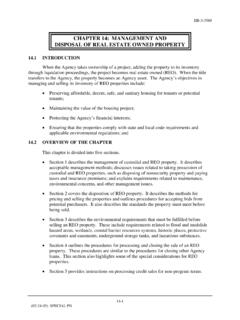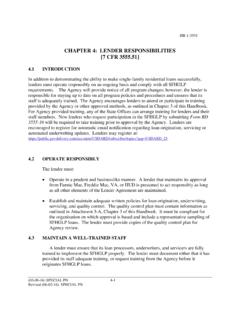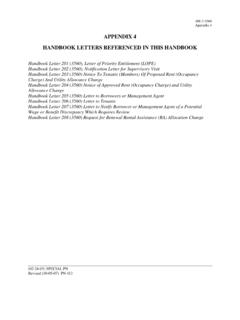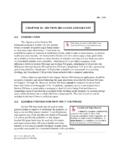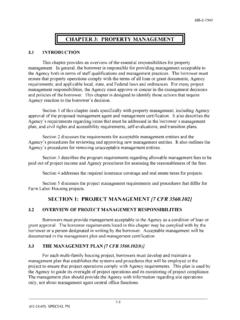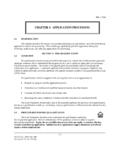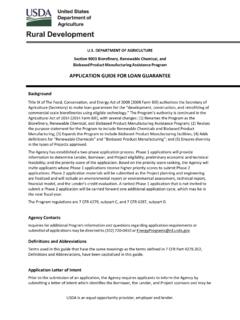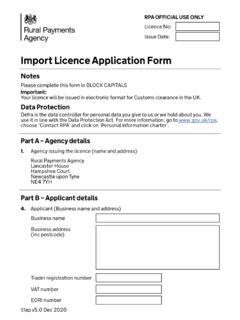Transcription of CHAPTER 11: RATIO ANALYSIS - USDA Rural Development
1 HB-1-3555. CHAPTER 11: RATIO ANALYSIS . INTRODUCTION. RATIO calculations are used to determine if the applicant's repayment income can reasonably be expected to meet the anticipated monthly housing expense and total monthly obligations involved in homeownership. The Agency has established standards for principal, interest, taxes, and insurance (PITI) and total debt (TD) ratios; however, there is flexibility to apply these standards when valid compensating factors are present. THE RATIOS. Ratios are calculated by utilizing the repayment income, as determined by the lender in CHAPTER 9 Section 2 of this Handbook. To qualify for a guarantee, borrowers must meet the Agency's standards for both the PITI and TD ratios. A. The PITI RATIO Applicants are considered to have repayment ability if their proposed monthly housing expense does not exceed 29 percent of their repayment income.
2 Monthly housing expenses include but are not limited to: Principal and interest payment on the mortgage;. Hazard insurance premiums, whether escrowed or not;. Real estate taxes, whether escrowed or not;. Monthly escrow required for annual fee;. Homeowners association dues and regular assessments;. Flood insurance premiums, whether escrowed or not; and Special assessments. B. The Total Debt RATIO Applicants are considered to have repayment ability when their total debts do not exceed 41 percent of their repayment income. The total debt RATIO includes monthly housing expense (PITI) plus other monthly credit or debt obligations incurred by the applicant. (03-09-16) SPECIAL PN 11-1. Revised (09-22-21) PN 554. HB-1-3555. Paragraph The Ratios The lender must document an applicant(s)'s debts through various records, including but limited to credit reports, direct or third-party verifications, court documents, and verification of deposits.
3 All open debts/accounts (including non-medical collection accounts and judgments) incurred through the note date must be considered in the total debt calculation and documented in GUS as well as the loan application as applicable. The following obligation expenses must be included in the monthly debts. 1. PITI. Principal, interest, real estate taxes, hazard insurance, monthly portion of the annual fee, HOA fees, special assessments, etc. 2. Installment accounts Accounts that will be paid in full through a specified number of fixed payments such as auto, personal, secured/unsecured, etc. must have the monthly payment included. If ten or less months of repayment remains per the credit report, creditor verification, etc., the monthly debt may be excluded if the payment does not exceed five percent of the monthly repayment income.
4 Installment debt may be paid down to ten months or less of remaining debt. 3. Revolving accounts Credit cards, lines of credit, secured/unsecured, etc. must include the minimum monthly payment documented on the credit report or other creditor verification in the total debts. If the credit report shows an outstanding balance, but no minimum monthly payment, the payment must be calculated as five percent of the balance reported on the credit report. The lender may obtain a current account statement or creditor verification to document the actual monthly payment and include that amount in the monthly debts. Revolving accounts with no outstanding balance on the credit report do not require an estimated payment to be included in the debt RATIO . Revolving accounts with no outstanding balance are not required to be closed.
5 11-2. HB-1-3555. Paragraph The Ratios 4. 30-Day Accounts A 30-day account is a credit arrangement requiring the applicant to pay off the full outstanding balance on the account every month. The lender may utilize the credit report to document the applicant has paid the outstanding balance for the previous 12 months. If the credit report reflects late payments in the last 12 months, the lender must include five percent of the outstanding balance in the monthly debts. 30-day accounts that are paid monthly in full are not included in the total debt RATIO . 5. Court Ordered Debts: Child support, alimony, garnishments, etc. Court ordered debts must have the payment included in the total debt RATIO unless the applicant has a release of liability from the court/creditor and acceptable evidence is documented. Lenders will utilize select pages from the applicable agreement/court order to document the required monthly payment due and the duration of the debt.
6 Court ordered debts with ten or less payments remaining may be excluded if the payment does not exceed five percent of the monthly repayment income. For GUS transactions, the lender will manually enter the obligation(s) as a monthly liability. A manual entry of this monthly obligation does not require an underwriting recommendation of Accept to be downgraded to a Refer.. Lenders must confirm repayment agreements are current. Refer to CHAPTER 10. for court ordered debt guidance and program eligibility. 6. Child Care Expenses Child care expenses are not required to be included in the monthly debt RATIO . 7. Student loans Lenders must include the required payment as applicable: Fixed payment loans: A permanent amortized, fixed payment may be used in the debt RATIO when the lender retains documentation to verify the payment is (03-09-16) SPECIAL PN 11-3.
7 Revised (09-22-21) PN 554. HB-1-3555. Paragraph The Ratios fixed, the interest rate is fixed, and the repayment term is fixed. The fixed payment will fully amortize/pay in full the debt at the end of the term. Non-Fixed payment loans: Payments for deferred loans, Income Based Repayment (IBR), Income Contingent (IC), Graduated, Adjustable, and other types of repayment agreements which are not fixed must use: o The current documented payment under the approved repayment plan with the creditor, when the payment amount is above zero; or o One half (.50) percent of the outstanding loan balance documented on the credit report or creditor verification, when the payment amount is zero. Student loans in the applicant's name alone but paid by another party remain the legal responsibility of the applicant. The applicable payment must be included in the monthly debts.
8 Student loans in a forgiveness plan/program remain the legal responsibility of the applicant until they are released of liability from the creditor. The applicable payment must be included in the monthly debts. 8. Mortgages: Rental Property A GUS Accept recommendation will not require a manual downgrade to a Refer when the net monthly rental income is negative. Income received from rents may only be counted for repayment if received for 24 months or more. If the credit report reflects late mortgage payments on the rental dwelling in the 12 months prior to loan application, the full mortgage liability and all associated costs must be included in the monthly debts. Refer to CHAPTER 9 for rental income guidance. 9. Mortgages: No Release of Liability Mortgage liabilities disposed of through a sale, trade or transfer without a release of liability ( , borrower remains on the promissory note) must be included in the total debt RATIO unless evidence can be obtained to confirm the remaining party/new owner has successfully made the payment for the previous 12 months prior to loan application.
9 11-4. HB-1-3555. Paragraph The Ratios Evidence may be reported through the credit report or verification from the creditor/servicer to document the payment history has been current for the 12. months prior to loan application. If there are late payments in the previous 12 months prior to loan application, the full mortgage obligation must be included in the monthly debt. 10. Mortgages: Divorce In the case of a divorce, the lender must obtain a copy of the legal separation agreement or divorce decree to document the remaining party/new owner responsible to pay all mortgage debts from the effective date of the decree forward. To exclude the mortgage debt, the lender must document the previous 12. months have been paid as agreed prior to loan application through the credit report or verification from the creditor/servicer.
10 If there are late payments in the previous 12 months prior to loan application, the full mortgage obligation must be included in the monthly debts. 11. Co-signed obligations Co-signed debts refer to a debt where the applicant may be a co-borrower, joint obligor, co-signer, guarantor, etc. Co-signed debts must be included in the monthly debts unless the applicant provides evidence another obligor (party to the debt) has successfully made the payment for the previous 12 months prior to loan application. Acceptable evidence includes but not is limited to: canceled checks, money order receipts and/or bank statements of the co-obligor. Late payments reported in the previous 12 months prior to application will require the monthly liability to be included in the monthly debts. If the applicant can provide conclusive evidence from the creditor that they will not pursue debt collection against the applicant should the other party default, the 12-month payment history of the additional party is not required.

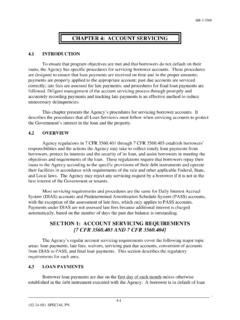
![CHAPTER 14: FUNDING [Official Agency Use Only]](/cache/preview/5/1/5/b/5/3/5/c/thumb-515b535cec62fd2bb25fbb788ef1c7a2.jpg)
